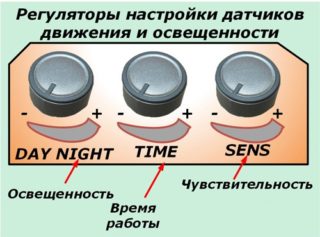Saving energy is one of the main challenges that people are trying to cope with. For this, energy-saving devices and automation systems are used. It is possible to save energy on the lighting group by switching to LED lamps with a motion sensor for the home. This device only works when someone is in the room and turns off when the room is empty. Lamps with a motion sensor are used in living rooms, offices and enterprises.
Principle of operation and purpose
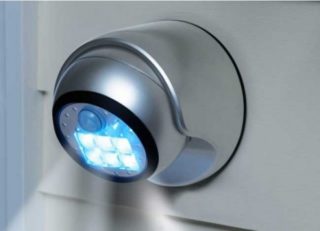
The motion sensor LED light works automatically. He scans the area of space that is included in their field of view, and captures movement in it in various ways. The impulse causes the circuit to close, causing the light to turn on. In the absence of movement, the chain is disconnected and the light goes out.
A quality luminaire should have a number of features:
- Do not react to small to medium sized pets.
- Disconnect after leaving the premises of all people.
- Possibility of setting the time interval.
- Work only in the absence of sufficient lighting.
Such devices are wired and wireless. They can be equipped with other sensors - for example, a photo relay, which will turn on the lamp only in the evening or at night.
It is recommended to use LED lamps to work with the motion sensor. This is due to their energy efficiency, economy, safety, and long service life. They are more expensive than conventional lamps, but quickly pay off during operation.
Types of LED lamps
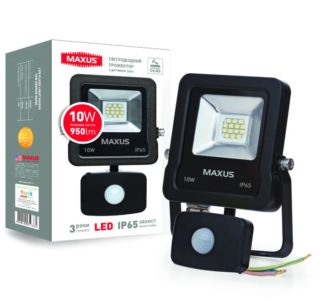
There are different classifications of LED devices. By appointment, there are:
- Street lights. Parks, alleys, streets are illuminated.
- LED floodlights. They have high power, increased sensitivity. Placed at especially important guarded objects.
- Luminaires with sensor. They are installed in apartments and houses, as well as in stairwells and in the stairwell.
The motion sensor can be built into the luminaire itself or into a separate housing, which is placed at a distance from the lamp.
By the way of power supply, wired and wireless devices are distinguished. The wired one connects directly to the electrical wiring, while the wireless gets its power from batteries or accumulator. Products powered by an outlet are installed in rooms of frequent use - kitchen, bathroom, toilet, corridor. Stand-alone models are placed in garages, closets, storage rooms, staircases.
Design of luminaires with DD
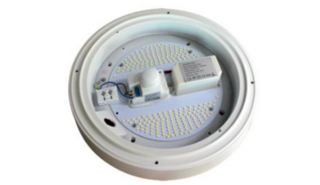
Design features depend on the purpose of the lamp. Outdoor devices must be adequately protected against aggressive environmental influences.
Home models are used only inside the home. Floodlights can be installed both outdoors and indoors.
On sale you can find a cartridge in which a motion sensor is built. It can be screwed into any lighting fixture instead of a standard socket or installed into it. Then the device will act as an adapter.
Specifications
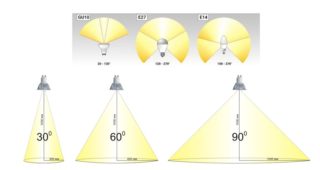
The main technical parameters of LED light sources with a motion sensor include:
- Power. Affects illumination and energy consumption.
- Colorful temperature.Gives either cold, warm or neutral white light.
- Scattering angle.
- The number of LEDs in the case.
- Working temperatures.
- Working voltage.
- IP protection class.
The characteristics of the detector itself must also be taken into account:
- Sensitivity.
- Viewing angle.
- Ability to work in extreme weather conditions.
- Working temperatures.
- Power.
- Levers for setting parameters.
The most expensive devices are ceiling luminaires with maximum viewing angles that work in all directions.
How to place lamps on the ceiling
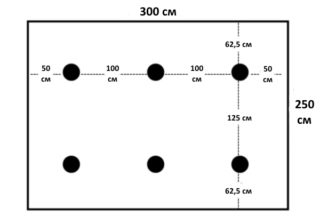
The most uniform illumination throughout the room is the main task of the luminaire, regardless of the presence or absence of a motion sensor in the design. Therefore, the first step is drawing up a layout and calculating the required number of lamps.
When creating a layout for placing LEDs on the ceiling, you need to use the following recommendations:
- For 1 sq.m. the living room should have at least 3 watts of lighting. In the bathroom and in the bedroom - 2 W / sq.m., In the corridor 1 W / sq.m. In the children's room, the lighting level should be 8 W per 2 sq. M. This is due to the presence of a play area and an indoor workplace.
- Accommodation depends on the individual characteristics of the room. In the bathroom, lamps are placed around the perimeter at an equal distance from each other. The living room has a central chandelier and several spotlights along the walls. The same is done in the bedroom, but the light should be dim.
- If there are wall cabinets, the luminaires must be moved 20 cm from the edge of the object to the center of the room.
It is important not to forget about the power of the light sources. For stretch ceilings, this value should not exceed 35 W in order not to deform the canvas.
Installation and configuration
The connection steps are as follows:
- Choice of installation site.
- Power outage at the switchboard.
- Connection of a standard type rocker switch.
- Connecting the luminaire to the contacts of the switch and the network. Installation of grounding as required. The wires must be connected in accordance with the marking.
- Insulation of joints.
- Setting up the sensor. It is performed by turning the corresponding levers. The settings are made according to the user's requirements and depend on the individual characteristics of the room.
Standalone wireless models are connected in the same way, but instead of a fieldbus, battery terminals are used.
Operating rules

To maintain the device's performance during the stated period, correct operation must be observed. The main requirements are:
- Avoid frequent triggering.
- Clean the shade.
- Disconnect the device from the mains if damage or defects are found.
To reduce the number of false alarms, do not place a lamp with a light sensor near heating and air conditioning systems, near traffic or near trees.

